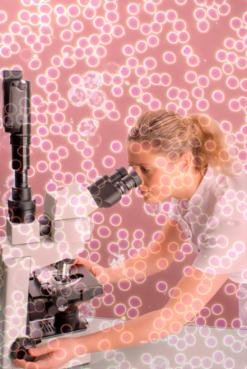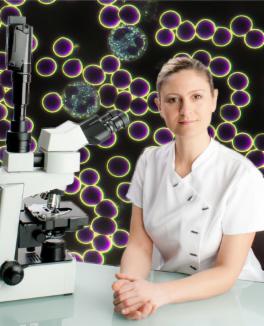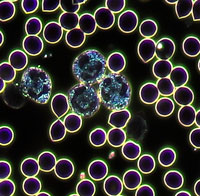What is Live Blood Analysis?
Live Blood Analysis is a
method used to view the current state and quality of your blood. A single living drop of your blood, taken
from the tip of your finger, is put under a microscope and magnified 1000
times or more.
This brings you a real visual of your blood’s behaviour. This is
a different method to “staining blood” used in medical laboratories, that search
for diseases, as they stain it with chemicals which kill it, therefore lots
can be missed under the microscope from the blood’s behaviour. I do not use Live Blood Analysis for
diseases themselves, or as a diagnostic tool, but to see any changes within
your blood ecosystem relating to the digestive system health, and especially due
to stress activity. This is a great tool to use when going through a Detox
program, as to witness the difference of toxicity before and after a course of colonics and enema treatments.
I
will introduce you to Dr. D'Adamo's method as the right foods to eat according to your blood type. I used this method myself when I was diagnosed with Irritable
Bowel Syndrome, to find
out what was causing my gut's discomfort, and it helped me
greatly. It is a very basic starting point and an easy way to learn about
your own
body and how to improve your health.
Live Blood Microscopy can be a real life
changing experience. It certainly was for me. It somehow illuminates some areas
of our health that we didn’t quite know about. It provides a key to
understanding ourselves better, and even offers a glimpse into our future
health. It really has a strong influence in altering awareness, and therefore
helps us moving toward the right direction when it comes to our health. Live Blood Analysis can amplify curiosity about your
health, and quite easily increase your determination in making changes necessary
to better yourself.
|
Is it worth knowing, that all our
blood cells are manufactured within our red bone marrow, and that also, there is
a gradual replacement cycle of red to yellow marrow throughout our life, within
our red bone marrow.
Once we reached our adulthood, our blood cell production
is then limited to flat bones, irregular bones and at the ends of long bones.
The
main sites being the sternum (breastbone), ribs, pelvis and skull. Blood is composed of
straw-coloured transparent fluid called plasma, where a variety of cells
are suspended such as our:- Red blood cells (carriers of oxygen and carbon
dioxide)
- Platelets (blood clotting cells)
- White blood cells (our body’s
guardians and fighters, against harmful events at a physical and
emotional level)
| In health, the blood is slightly alkaline with a maintained PH
of between 7.35 to 7.45
|
Our Blood has a multi-tasking talent and it can: - Carry oxygen from the lungs to the tissues
- Bring carbon dioxide back from the tissues to the lungs for elimination
- Carry
our food from our digestive system to the tissues
- Bring cell waste from
food breakdown mostly to the kidneys for filtration
- Carry hormones to
their target sites (ie: glands and tissues)
- Transfer heat from a warmer
site in our body towards less active tissues
- Carry protective substances
(ie: antibodies) to infected areas
- Carry clotting factors that coagulate
blood, lessening bleeding from ruptured blood vessels
Plasma also makes about 55% of our blood volume
and our cells about 45%
|
The plasma is 90 to 92% composed of water
with dissolved substances such as:
- Plasma proteins (important to maintain osmotic pressure of our blood or else, fluid retention may arise)
- Inorganic mineral salts (essential to keep our blood acid-base ratio balanced, for healthy muscle contraction and transmission of nerve impulses)
- Nutrients, principally from digested foods which have been broken down into small molecules, e.g: monosaccharides, amino acids, fatty acids and glycerol for absorption (these are important to provide energy, heat, materials for repair and replacement and for the making of other blood components and body secretions)
- Waste materials (the result of protein metabolism, e.g: urea, creatinine and uric acid are formed in the liver and carried in blood to the kidneys for excretion)
- Hormones (pass directly from the endocrine cells into the blood, then the blood can carry them to their target tissues and organs
- Gases (such as oxygen and carbon dioxide which are transported in combination with haemoglobin in red blood cells)
|
About red blood cells
Red blood
cells require both Vitamin B12 and folic acid for their production. Vitamin B12
is the hardest vitamin to absorb, as it has to have its own private
“taxi-driver”, (intrinsic factor) picking it up from the stomach, and
bringing it to its site of absorption, the small intestine (precisely in the
terminal ileum). Without binding onto this carrier, absorption will not take
place.
Folate and B12 vitamins are found in eggs, lentils, sprouts, green leafy
vegetables,
mackerel, sardines, salmon, oysters, herring, meat and liver.
Red blood cells have a fairly constant turnover, as the bone marrow produces them at the rate at which they are destroyed.
If overproduction of red blood cells occur, it is likely to be because there is
either excessive red blood cells breakdown (due to disease), heavy blood loss
(haemorrhage), or you find yourself in high altitude with low oxygen supply. The
red blood cell shape is extremely purposeful. They look like doughnut shaped
cells. This biconcavity form increases their surface area for gas exchange,
while its central thinness allows a faster flow between the entry and exit of
those gases. Red blood cells life span is approximately 120 days. Some
immature cells can be seen in Live Blood Microscopy, as they are still forming
over a day or two within the circulation. This is a normal process of red
blood cell production, although too many immature cells noticed under the
microscope could show a Vitamin B12 and folic acid deficiency. You might show
fatigue as an example, but also a vitamin and nutrient malabsorption in
general, leading you to other health issues.
Red
blood cells as they age, get destroyed mainly in the spleen, bone marrow
and the liver |
About white blood cells
Not just the guardians and fighters of our blood, our white blood cells (also called leukocytes) efficiently clean the leftover from any aftermath of a fight our body has to go through, such as:
- An allergic response (hay fever, food sensitivity)
- A viral infection (cold)
- A bacterial infection (Candida albican)
- An injury
Live Blood Analysis is a great visual on why certain white blood cells shouldn’t be there, unless you are going through these conditions.
It brings you a better understanding of why you are feeling a certain way too, which is quite amazing really! Just think of your blood being purely a reflection of the stress you are experimenting at that precise moment, let it be physical or emotional, your immune system (white blood cells) will definitely show it. All the different types of white blood cells have a precise role to play within our body, even if they account for about 1% of the blood volume. Let me give you an insight on each of those amazing little guys. I think it’s important that you have some kind of understanding about it all before you come and see me. You should enjoy the consultation, and ask questions when you see certain cells you might recognise. It’s about your blood yes, but it is mostly about the experience!
Let’s start with the neutrophilsThese white blood cells are
the “protectors” of them all.
They do not let
anything harmful, entering our body and especially microbes! They will also
remove some waste materials hanging around. You will see them under the
microscope in a big number when infection occur, as neutrophils are
attracted to a chemical substance released by damaged and stressed
cells.
Their numbers therefore, increased towards:
- A microbial infection
- Extensive tissue damage (due to inflammation, burns or crush injuries)
- A metabolic disorder (acute gout)
- Heavy smoking
- Use of oral contraceptives
| The only time where a normal increase of neutrophils should occur, is when you had a strenuous exercise and in the later stages of a normal pregnancy
|
Eosinophils are more specialised toward parasites elimination such as worms. They are equipped with powerful toxic chemicals in order to attack those bigger organisms. They are also seen under the microscope if you are prone to allergic reaction such as asthma or skin allergies.
Basophils are the white blood cells closely associated with allergic reactions, such as pollen allergy in hayfever, and you would see them under the microscope, if you were going through this type of condition.
Monocytes are divided in two types of cells. Some are actively motile, and circulate within our blood to act as what I like to call a “pac-man patrol”. They gulp anything that shouldn’t be in our blood such as:
- Waste materials
- Harmful micro-organisms
- Other foreign bodies in the bloodstream and tissues
Other monocytes are fixed, and multiply at a site where they detect a large amount of foreign or waste materials.
Their behaviour reminds me of a police forces using the “kettling technique”, as they “wall off” the area in order to control any sort of spreading from an infection or inflammation. Then they can release an array of chemicals onto them.
All very fascinating! If you would like to learn about your blood, and see how it behaves under the microscope, make an appointment soon to come and enjoy the experience.
Click here for prices on Live Blood Analysis
If you need anymore information, please, email or call me on 0207 247 7742 within the hours of 9.30am to 8pm
Monday to Saturday, I will be happy to answer any enquiries you might have.
Therapies offered at 4 Balance and
Health are not substitutes for traditional medical care by your GP, they
are complementary therapies that may be used in conjunction with
conventional medicine. Should you be aware of any reasons why these
therapies are contra-indicated to you or you have a serious health
problem, please consult your GP prior to their use.
| |


